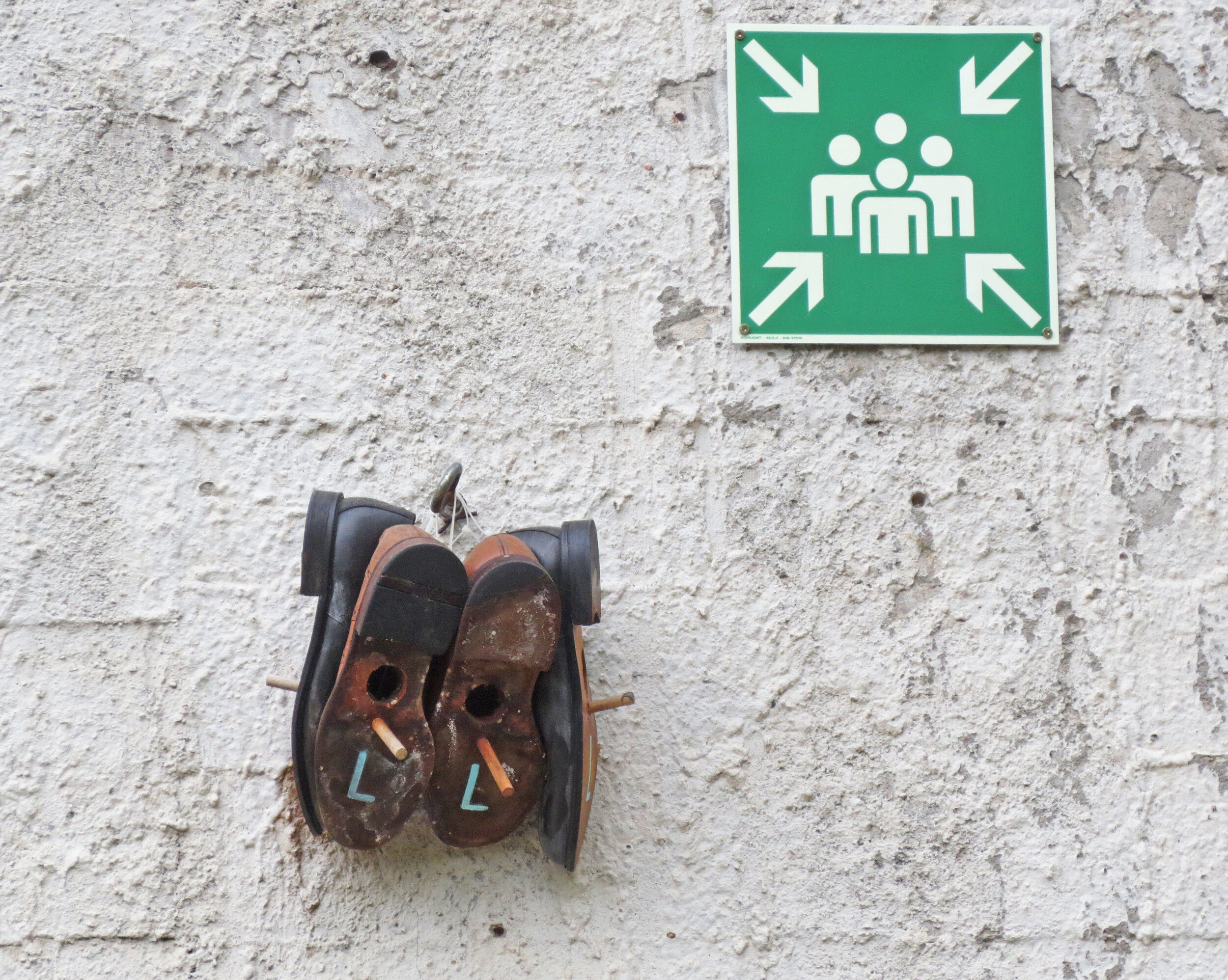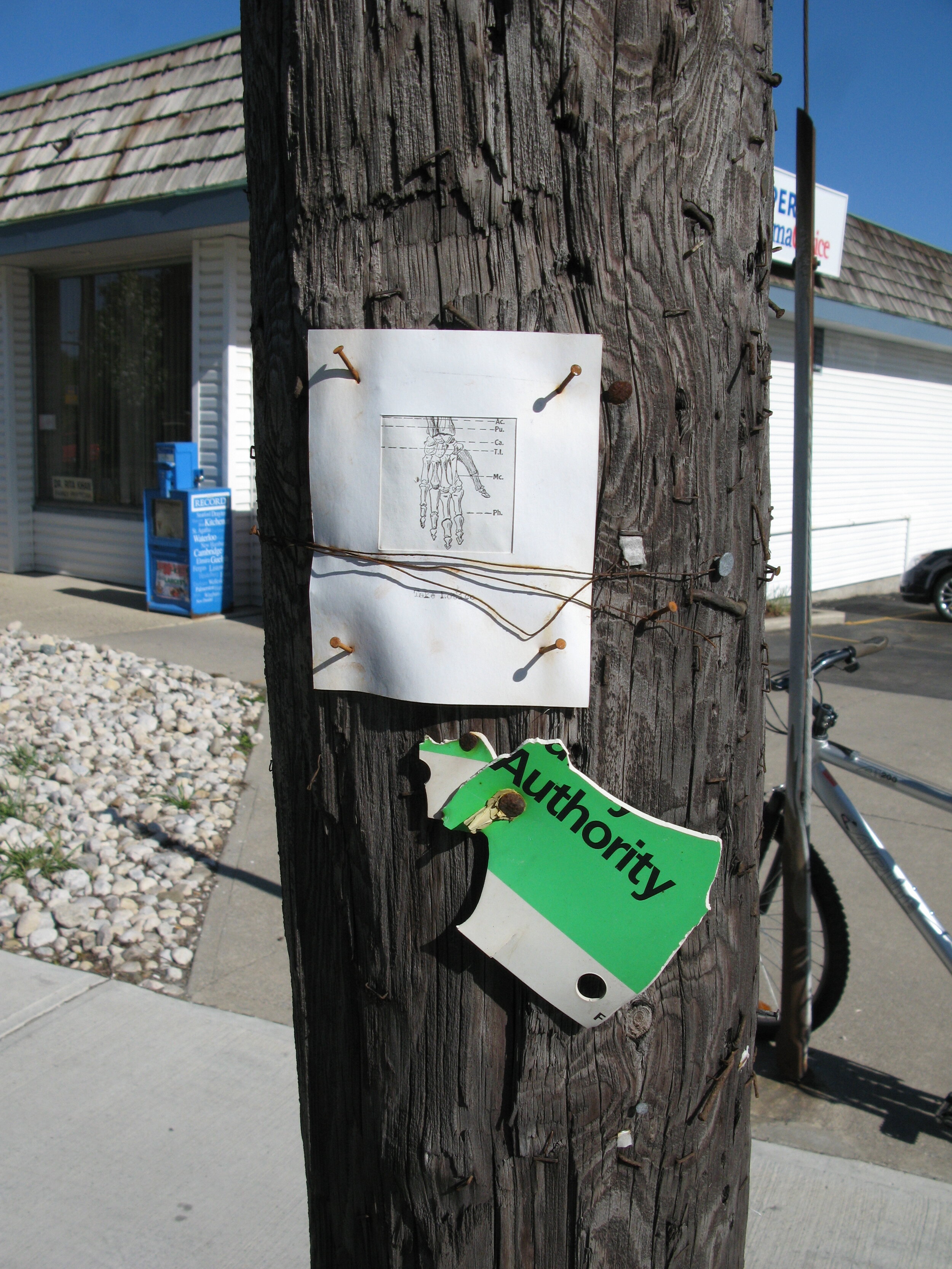A few left shoes hung on a nail on the wall of an historic bunker in Berlin, Germany. Holes drilled into the soles and wooden pegs. Bird houses?
A clock and clipboard on a tree in Chaing Mai, Thailand. Taxi stand?
Wooden shelves built into the wall surrounding a parking lot in Madurai, India. Someone’s former living room?
Jesus opening and closing his eyes in a portrait resting in a wall niche in Naples, Italy. Shrine? Joke?
Every once in a while, while walking, I come across something that catches my eye and requires that I stop for a closer look: Something that seems out of place, unexpected, preying on my curiosity and insisting on further investigation. Almost always I end up asking myself “What is this?” or “Why is this here?” And I so enjoy those small moments of discovery for the delight and for the fresh perspective it brings to my day.
These discoveries occur more frequently while traveling. What seems entirely unremarkable to those in one place is eye opening to others. Just as the things that I consider unremarkable have therefore become invisible to my eyes, outsiders to my world can quite clearly see the curiosity or oddity that these same things hold. It is less about the object than about the viewer’s point of view. These small moments of discovery reveal the individual humans who have inhabited that particular space previously, leaving an object behind that holds only a clue as to what is held in the heart and mind of a person whom I will never meet. And the act of discovery reveals something about the one who has eyes to see it, to notice it.
Near the city where I live, there was, until recently, a pair of teddy bears tied to a sign. What tragic event unfolded on Wilmot Road 8, that would have someone mark a place like this? I’ve thought about it every time I have driven by, creating variations of the story and watching, in cinematic imagination, as a grieving family meets at an accident site to create a roadside memorial to a lost child.
It reminds me of the doll’s head I discovered looking over the corner of a house in Albania. After seeing numerous stuffed animals and dolls on fences, walls and rooftops, I began to realize it wasn’t scarecrows or memorials I was noticing, but something else. It turns out that they are dordolecs, objects placed outside of homes to protect against the harm caused by the envious or evil eye. Is there harm in the inquisitive eye of a traveler, too? Taking walks in Albanian villages became more than just enjoying the olive groves and old stone houses, but the constant eye-spy search for more dordolecs. To me these objects were a curiosity, but what deeply held beliefs and rituals of mine are a mere curiosity to others?
Sometimes what I discover is a more practical object, like the clock and clipboard on a tree by a Chiang Mai street. Unexpected to me, but part of someone else’s daily routine. Not long ago, someone in my city made local news by bolting telephones and other household items to hydro poles. Maybe it was art. I particularly like the bird house shoes I discovered in Berlin for their impractical usefulness. Would birds really move into these shoe-houses? They certainly wouldn’t see the aesthetic value of the object… but then, I’m guessing, many humans wouldn’t either.
Objects found in public spaces, lacking explanation or the context of human activity to explain them create a situation ripe for discovery, delight and curiosity. They also find themselves open to interpretation. This is what I enjoy about creating art for spaces beyond the gallery, even if it leads to unexpected outcomes.
Two situations illustrate this:
With my Time Stop project, musical microgalleries installed on utility poles in the neighbourhood where I live, I ran into trouble with the city officials. It was Easter morning a few years ago that I got a knock on the door only to find a police officer asking if I was the one who had put the metal boxes on the poles. Apparently someone had found one and saw it as a threat, a possible object of danger or intimidation. Yes, there was a glass flask of unknown liquid inside (water), and some objects and images meant to provoke a certain anxiety about the environmental crisis we face. What was clearly art to me was a cryptic and frightening threat to someone else, leading them to call the police. Perhaps it was misinterpreted as the kind of cliché creepy object created by a warped criminal mind in the kind of over-dramatized psychological thriller or horror movie so typical on streaming services these days. Fair enough, I suppose. One’s interpretation might depend on whether more time is spent watching Netflix crime series than enjoying contemporary art. In any case, I was late for a family reunion, spending my morning instead removing all fifteen Time Stops under the watchful eye of the bylaw officer who was ensuring that I followed orders as required!
Paul Roorda, Time Stop X, interactive musical microgallery with vintage objects, 2017
Another project resulted in similar problems with context. A number of years ago I framed vintage encyclopedia images in paper cards with the words “Take Notice” typed below. Again, with the intention of acting as a quiet warning about climate crisis and at the same time urging people to delight in taking notice of the unexpected curiosities around them, I attached these notices in great numbers to utility poles around my city with nails and wire. Invited to have an exhibition at the Ottawa City Hall Art Gallery, I installed these notices in the streets surrounding city hall there as well. They were, before long, torn down by maintenance crews trying to keep the downtown neighbourhood free from visual eyesores. Ironically, the same city tax dollars were spent hiring the installation crew to assist with nailing notices from the project to the white walls of the gallery. Context makes a difference!
Paul Roorda, Take Notice, 2011.
Paul Roorda, Take Notice, detail of installation at Ottawa City Hall Art Gallery, 2011
I suppose there is value in protecting our public spaces so they remain clean, safe and welcoming. But there should be room for some delight in the unexpected: A remnant object from someone else’s day, a creative mark, a political statement, an artifact of history or belief, an object for remembering. These are small gifts from one person to the next, not from hand to hand, but through overlapping moments of space and time. And, as such, they are only tiny windows to see into the life of another. Like overhearing a few sentences of a long conversation in passing a couple talking on the sidewalk. Or like the distorted view through a door’s peephole lens, only seeing enough to determine who is on the other side. Whether you stop to engage in conversation or to let the person in is another choice altogether. But even if not, the peephole view or snippet of conversation is enough to leave you with a spark of curiosity where you fill in the gaps, connect some dots, and create your own story to make sense of it. For a brief encounter that might become an enduring memory, a moment of their story becomes a moment of yours, imagined through your own idiosyncratic point of view and experience, told in your voice with freshly unfolding details and remembered with your own collection of embellishments. The unremarkable made remarkable.
For more Albanian dordolec photos, go to my travel blog, roordaphotos.wordpress.com.
Go to Take Notice or Time Stops for more photos and information on these public art projects.








